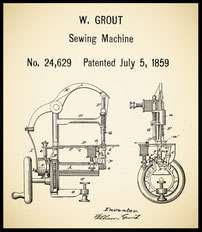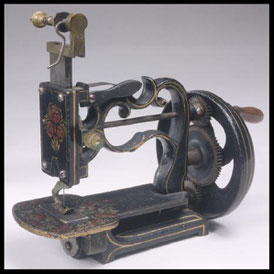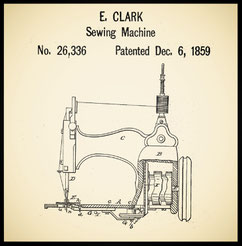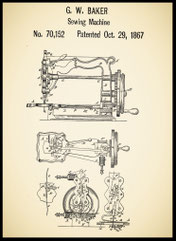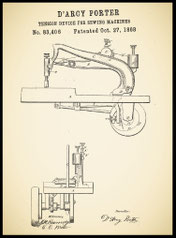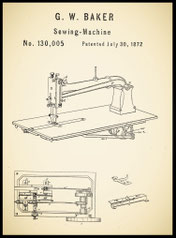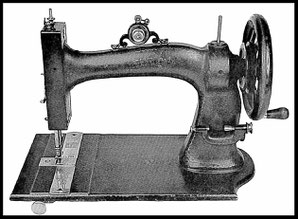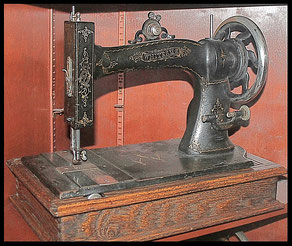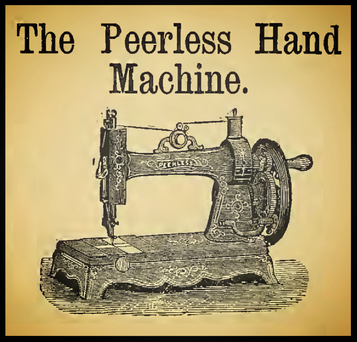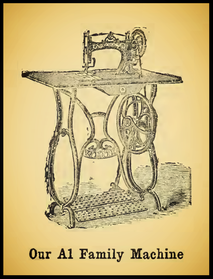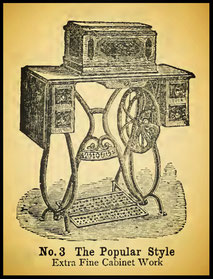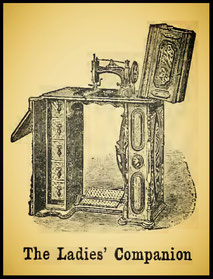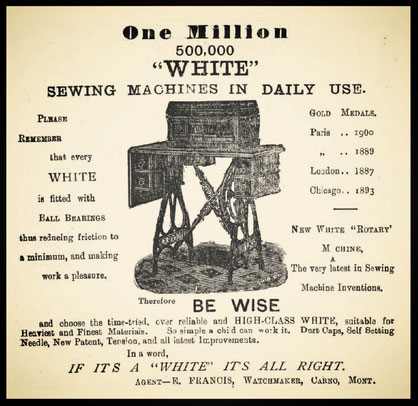- HOME
- Primary Sources
- The Invention of the Sewing Machine by Grace Rogers Cooper
- The Sewing Machine Combination or Sewing Machine Trust
- Vibrating Shuttle Sewing Machines History
- Running-Stitch Machines
- Button-Hole Machines
- Book-Sewing Machines
- Glove-Sewing Machines
- Shoe Making Machines
- Needles
- Shuttles & Bobbins
- Bobbin Winders
- Thread Tension Regulators
- Feed Reversing Mechanism
- Attachments and Accessories
- MANUFACTURERS AND DEALERS IN SEWING MACHINES
- BIOGRAPHICAL SKETCHES
- PATENTS
- DATING FRISTER & ROSSMANN
- FRISTER & ROSSMANN
- BRITISH Machines
- BRITISH Machines Part 1
- BRITISH Machines Part 2
- BRADBURY & Co.
- BRITANNIA SEWING MACHINE COMPANY
- BRITISH SEWING MACHINE COMPANY Ltd
- ECLIPSE MACHINE COMPANY
- ESSEX
- GRAIN E. L. Ltd
- W. J. HARRIS & C0.
- IMPERIAL SEWING MACHINE CO.
- JONES & CO.
- LANCASHIRE SEWING MACHINE Co
- SELLERS W.
- SHEPHERD, ROTHWELL & HOUGH
- VICKERS
- WEIR'S
- AMERICAN Machines
- AETNA SEWING MACHINE
- AMERICAN B.H.O. & SEWING MACHINE COMPANY
- AMERICAN SEWING MACHINE COMPANY
- AVERY SEWING MACHINE COMPANY
- BARTHOLF SEWING MACHINE COMPANY
- BARTLETT SEWING MACHINE COMPANY
- BARTRAM & FANTON Mfg. Co.
- BECKWITH SEWING MACHINE Co.
- BOYE NEEDLE COMPANY
- BURNET, BRODERICK & CO.
- CONTINENTAL MANUFACTURING Co.
- DAVIS SEWING MACHINE CO.
- DEMOREST SEWING MACHINE MANUFACTURING CO.
- DOMESTIC SEWING MACHINE COMPANY
- DORCAS Sewing Machine
- EMPIRE SEWING MACHINE COMPANY
- EPPLER & ADAMS SEWING MACHINE COMPANY
- GOODSPEED & WYMAN S.M. Co.
- GREIST MANUFACTURING COMPANY
- GROVER & BAKER SMC
- HEBERLING RUNNING STITCH GUAGING MACHINE Co.
- HIBBARD, SPENCER, BARTLETT & Co.
- HODGKINS MACHINE
- HOWE MACHINE COMPANY (Elias)
- HOWE S. M. C. (Amas)
- N. HUNT & CO.
- HUNT & WEBSTER
- JOHNSON, CLARK & CO.
- LEAVITT & CO.
- LEAVITT SEWING MACHINE COMPANY
- LEAVITT & BRANT
- LENOX MANUFACTURING COMPANY
- NETTLETON & RAYMOND SEWING MACHINES
- NEW HOME SEWING MACHINE COMPANY
- NICHOLS & BLISS
- NICHOLS & Co.
- NICHOLS, LEAVITT & CO.
- REMINGTON SEWING MACHINE COMPANY
- REECE BUTTON HOLE MACHINE COMPANY
- SINGER
- SMYTH MANUFACTURING COMPANY
- UNION BUTTONHOLE and EMBROIDERY MACHINE COMPANY
- UNION BUTTON-HOLE MACHINE COMPANY
- UNION BUTTON SEWING MACHINE COMPANY
- TABITHA Sewing Machine
- WARDWELL MANUFACTURING COMPANY
- WATSON, WOOSTER & Co.
- WEED SMC
- WHEELER & WILSON
- WHITE SEWING MACHINE COMPANY
- WILLCOX & GIBBS
- WILSON SEWING MACHINE COMPANY
- CANADIAN Machines
- GERMAN Machines
- Deutsche Nähmaschinen-Hersteller und Händler
- Development in industrial sales
- About innovations on sewing machines
- Bielefeld Nähmaschinenfabriken
- Nähmaschinen in Leipzig
- ADLER
- ANKER-WERKE A.G.
- BAER & REMPEL
- BEERMANN CARL
- BELLMANN E.
- BIESOLT & LOCKE
- BOECKE
- BREMER & BRÜCKMANN
- CLAES & FLENTJE
- DIETRICH & Co.
- DÜRKOPP
- GRIMME, NATALIS & Co.
- GRITZNER
- HAID & NEU
- HENGSTENBERG & Co.
- JUNKER & RUH
- KAISER
- LOEWE & Co. / LÖWE & Co.
- MANSFELD
- MÜLLER CLEMENS
- MUNDLOS
- OPEL
- PFAFF
- POLLACK , SCHMIDT & CO.
- SCHMIDT & HENGSTENBERG
- SEIDEL & NAUMANN
- SINGER NÄHMASCHINEN IN GERMANY
- STOEWER
- VESTA
- WERTHEIM
- WINSELMANN
- ITALIAN Machines
- HUNGARIAN / MAGYAR Machines / Varrógépek
- AUSTRIAN Machines
- BELGIAN Machines
- FRENCH Machines
- RUSSIAN Machines
- SWEDISH Machines
- SWISS Machines
- NATIONAL & INTERNATIONAL EXHIBITIONS
- 1850 NEW YORK - FAIR
- 1850 BOSTON
- 1851 LONDON
- 1851 NEW YORK - FAIR
- 1852 NEW YORK - FAIR
- 1853 NEW YORK - FAIR
- 1853 BOSTON
- 1853 DUBLIN
- 1853-4 NEW YORK
- 1854 MELBOURNE
- 1855 NEW YORK - FAIR
- 1855 PARIS
- 1856 BOSTON
- 1856 NEW YORK - FAIR
- 1860 STUTTGART
- 1861 MELBOURNE
- 1862 LONDON
- 1866 ALTONA
- 1869 BOSTON
- 1873 VIENNA World Exhibition
- 1876 PHILADELPHIA
- 1884 LONDON Health Exhibition
- 1884 LONDON International and Universal Exhibition
- 1885 LONDON South Kensington Exhibition
- 1887 LONDON American Exhibition
- 1889 PARIS Exposition Universelle
- 1893 LONDON The Sewing and Domestic Machines' Show
- CURIOSITIES
- READING ROOM
- SEWING MACHINE MUSEUMS - Links
- USEFUL LINKS
DATING & IDENTIFYING
WHITE SEWING MACHINES
Maintaining this repository of heritage is a labor of love, and your support helps cover the essentials—hosting, domain, and ongoing curation. If Fiddlebase has been a valuable resource for you, or if you simply wish to honor Enrico's passion, consider contributing.
*********************************************************
Raymond 1857
A.F. Johnson US 20.686 June 22 1858
*********************************************************
1858-1861 Brattleboro, Vermont
Samuel Barker Stephen French
1862-1863 Orange, Massachusetts
William L. Grout Stephen French
1863-1866 Orange, Massachusetts
Stephen French George Wells Baker
1866-1876 White Mfg. Co. Cleveland, Ohio
From 1876 White Sewing Machine Company
George Wells Baker & D'Arcy Porter
1857
?
By 1857 Thomas H. White had invented a small hand-operated sewing machine (on which he obtained a US patent in 1859), starting his own business, with partner William L. Grout and $350 initial capital, making "The New England Sewing Machine", retailing for $10. Seeking a central location near markets and materials.
The National Cyclopaedia of American Biography (1931/vol.21)
William Grout of the city and county of Worcester, State of Massachusetts
*********************************************************
This small sewing machine, which has no identifying marks, may have been made in Brattleboro, Vermont by one of the two manufacturers operating there in the period from 1858-1865.
Thomas H. White and Samuel Barker made a machine known as the "Brattleboro" from around 1858 to 1861 and Nettleton & Raymond made the "Common Sense" brand machine in around 1857.
Collectively, all of these machines are known as "New England" style machines. It is possible, too, that it may have been made by one of several Massachusetts-based sewing machine companies.
In 1862, Thomas White left Vermont (Brattleboro) for Orange, Massachusetts, where he joined with William L. Grout for a year as Grout & White, but Grout broke with him and moved to Winchendon (Massachusetts), where he made machines for another year. Three other Orange, Massachusetts, based companies made these New England-style machines:
(Andrew J.) Clark & Barker (William?)(1862-65), Orange, Massachusetts.
Clark (Andrew J.?) (1865-67) Orange, Massachusetts.
Albert F. Johnson (1867) Orange, Massachusetts.
Finally, there were two Winchendon, Massachusetts-based companies making New England machines:
William L. Grout (1863) and J. G. Folsom (1865).
There is no record that these sewing machines were produced after 1867.
************************************************
US 20.686 Albert F. JOHNSON June 22 1858
************************************************
Barker stopped selling for White and formed another sewing-machine company together with A. J. Clark, called their machine "The Pride of the West" and later the "New England Machine".
In 1860, William Barker and Andrew J. Clark began producing The Pride of the West and later the New England single thread hand sewing machine in Orange, Massachusetts. Over the next 20 years, the New England machine and the "Home Shuttle" were their two most significant products.
In 1882, the company reformed under the name New Home (a combination of the labels New England and Home Shuttle) and it continued to operate under that name for the better part of a century.
***********************************************
Barker, who was White's main seller, decided to leave him and founded his own company, the Gold Medal Sewing Machine to produce a machine named "The Pride of the West" and later "the New England Machine". In 1867, Barker went back when he had started and settled his company in Orange just as his former employer Thomas White had done.
(Now offline): https://pages.perso.orange.fr/buisson/english/janome.htm
************************************************
*********************************************************
1858-1861
Brattleboro
ca. 1858-1861 Brattleboro, Vermont
Thomas Howard White and Samuel Barker
In 1858 in Brattleboro, Vermont, Tomas H. White and Samuel Barker, were manufacturing a small single thread family machine called the Brattleboro.
In 1858 Thomas H. White, with a capital of $350 and with William L. Grout, who acted as salesman, as a partner, began manufacturing sewing machines in in a factory at Templeton. "The New England" was the name of this machine, the retail price of which was ten dollars and although the partnership with Grout lasted only a year, the business prospered.
In 1861, Stephen French accepted a position with Thomas H. White, making a single thread "hand" sewing machine.
Brattleboro is a town in Windham County, Vermont.
Templeton is a town in Worcester County, Massachusetts.
The National Cyclopaedia of American Biography (1931/vol.21)
1862-1863
New England
1862-1863 Orange, Massachusetts
Thomas Howard White and William L. Grout
The manufacture of a revolving-Looper double-thread sewing machine, patented by Edwin Clark (US 26.336 December 6, 1859) and manufactured over three thousand by Lamson, Goodnow, & Yale of Windsor, Vermont, widely advertised and sold for $35 with a foot-power table, was discontinued early in the summer of 1861. The sewing-machine equipment and business was sold to William L. Grout & Thomas Howard White.
In 1862, Thomas White left Vermont and went to Massachusetts. There, in partnership with William L. Grout, he also began to manufacture New England machines; these were basically the same as the Raymond machines.
In 1862, Thomas H. White and Stephen French, who has been his mechanics since 1861, left their Templeton manufacture to settle in Orange, Massachusetts and Mr. Stephen French was given a share of the company.
New England
1863 Winchendon, Massachusetts
William Grout
In 1863 William L. Grout left the partnership with Thomas H. White and moved to Winchendon, Massachusetts, there continuing to make New England machines for approximately one more year.
1864-65
?
1866-76
In 1866, just after the Civil War, Thomas H. White moved to Cleveland, Ohio from Orange, Massachusetts with his son and three employees (his best mechanics) and there founded the White Manufacturing Company. It was there that the first prototype of a White machine was built.
In 1866 Stephen French, who has been Thomas H. White mechanics since 1861, refused to go and with John Wilson Wheeler and Andrew J. Clark who had all previously worked with Thomas White went on building sewing machines.
In 1866 Stephen French became the superintendent of the Gold Medal Sewing Machine Company and remained in Orange.
From 1866 to 1876, White Manufacturing Company new factory built sewing machine heads for W. G. Wilson, until that company purchased the existing patterns, templets, special equipment and established an independent plant in Chicago.
A new model had been perfected in the meantime by George Wells Baker and D'Arcy Porter of the White organization and its manufacture was commenced at once, the company was reorganized under the name of the White Sewing Machine Company.
*********************************************************
WHITE SEWING MACHINE COMPANY
1876-1879
This machine bears the serial number # 28.241 and the following US patents:
US 174.703 D'Arcy Porter & George W. Baker March 14, 1876
May 2, 1876
US 183.528 George W. Baker October 24, 1876
January 16, 1877
US 188.537 D'Arcy Porter March 20, 1877
US 188.767 George W. Baker March 27, 1877
Machines bears the above US Patents are manufactured between:
March 1877 c. and November 1881 c.
********************************************************
The White machines of the 1870s may be dated approximately as follows:
1 ..........................................................
1876
9.000 ...................................................
1877
27.000 .................................................
1878
45.000 .................................................
1879
63.000 .................................................
*********************************************************
US 194.067 George W. Baker & D'Arcy Porter August 14, 1877
Improvement in locking Devices for Drive Wheel for Sewing Machines
*********************************************************
1881
By 1881, the White factory was producing 8.000 sewing machines a month and nearly 900 men were engaged in the various stages of their manufacture.
Automobile quarterly by Princeton Institute for Historic Research.
100.000 machines per annum in 1881
The Sewing Machine Gazette 1881.
GB Patent 5.166 November 26, 1881
H. J. Haddan. A communication from D'Arcy Porter and T. H. White, both of Cleveland, United States, for improvements in sewing machines.
Consists in a mechanical movement which converts the rotary motion of the main horizontal driving shaft into a vibration motion for operating the shuttle bar and by the interposition of other mechanism at the same time communicates rotary motion to the feed shaft.
1882
The business grew from an original production of twenty-five machines a month to no fewer than 2.000 a week in 1882.
The National Cyclopaedia of American Biography (1931 vol. 21)
1883
US PATENTS
US 124.360 (?) March 5, 1872
No US Patent for WSMC or Assignor to WSMC
James A. House (W&W)
US 174.703 March 14, 1876
D'Arcy Porter & George W. Baker
May 2, 1876
October 24, 1876
January 16, 1877
US 188.537 March 20, 1877
D'Arcy Porter
US 188.767 March 27, 1877
George W. Baker
November 26, 1881
1884

1887
1889
1893
GB 19.629 G. Sawyer October i8th, 1893
A communication from the White Sewing Machine Company, of Cleveland, Ohio.
Relates to improved means or appliances for regulating and determining the tension of the thread from the head of a sewing machine, the tension being removable by the pressure foot left lever, in order that the thread may be readily drawn from the reel when a piece of work is completed, the tension not being otherwise affected, such as when the presser rises while seams or extra thickness of fabric are passing under it.
Sewing Machines present at the 1893 London Exhibition
Plates on the above sewing machine may have been exchanged.
The patent dates on the bobbin winder are:
March 5, 1872
US 174.703 March 14, 1876
May 2, 1876
January 16, 1877
March 20, 1877
US 188.767 March 27, 1877
The patent dates on the bobbin winder are:
May 14, 1872
US 174.703 March 14, 1876
July 11, 1882
1902
1914 ?
?
WHITE
Rotary
With the Great Depression came renewed interest in home sewing. White continued to innovate, introducing the first sewing machine outside of its traditional black models, which was made of a magnesium alloy and was also much lighter than its forebears.
WHITE
Rotary No 15
********************************************************************************************************************
QUICK DATING
1 .........................................................
1876
9.000 ..................................................
+ 18.000 1877
27.000 ................................................
+ 18.000 1878
45.000 ................................................
+ 18.000 1879
63.000 ................................................
+ 27.000 (?) 1880
90.000 ................................................
+ 96.000 1881 (8.000 per month)
186.000 ...............................................
+100.000 1882 (2.000 per week)
286.000 ...............................................
+ 84.000 (?) 1883 Improved VS White
370.000 ...............................................
+ 60.000 1884 500.000 Sewing Machines in use
430.000 ...............................................
1885
490.000 ...............................................
1886
550.000 ...............................................
1887
610.000 ...............................................
1888
670.000 ...............................................
1889
730.000 ...............................................
1890
790.000 ...............................................
1891
850.000 ...............................................
1892
910.000 ...............................................
(1.000 per week) ?! 1893 (1.000 per day) 1893
970.000 ...............................................
1894
1.030.000 ............................................
1895
1.090.000 ............................................
1896
1.150.000 ............................................
1897
1.210.000 ............................................
1898
1.270.000 ............................................
1899
1.330.000 ............................................
1900
1.400.000 ............................................
1901
1.470.000 ............................................
1.500.00 July 1902 (Advertisement)
1.550.000 ............................................
1.389.763 (?)
1903
1.407.808 (?)
............................................
1904
............................................
1905
............................................
1906
............................................
1907
............................................
1908
............................................
1909
............................................
1910
............................................
1911
............................................
1912
............................................
2.276.398 Sept. 1913
2.300.000 ............................................
1914
............................................
1915
............................................
1916
............................................
2.657.168 1917
............................................
1918
4.000.000 ............................................
Approx.
... to be continued ...
From Treadleon.net
White Numbers/Years
The White company (still in business) has some serial number records and will date machines. Their record and numbering system is/was not as organized as Singers, so there are some problems. However, we are assembling a record of known dates to provide a rough comparison ability.
The following White numbers were verified through the company. You will note that there are irregularities in the stated sequences. Neither we nor the company have any explanation for this. Hopefully, you can use the list for a quick check on the age of your White. If you call the Husqvarna/Viking/White company at 1 800 446-2333, they will date your machhine for you.
VS - the White VS was introduced in 1876. Books credit it through the 1880's but White records show it continuing into the 1900's. VS I has round tension on upper arm. VS II came out in the 1880's. The tension was by means of a nut on the machine head, but had no dial. VS III came out in the 1890's and had the tension dial, similar to the FR models.
1.163.248 (this number is from the 1800's. White records start in 1900)
1.368.882 .......... 1903
1.759.040 .......... 1915
1.800.124 .......... 1919
Family Rotary - The Family Rotary, or FR, came out in the 1890's, and in various models continued well into the 1930's. FR serial numbers were used on badge machines as well as those labeled "White".
FR 140.336 pre-1900
FR 127.544 ... 1906 (Note: It has been reported that #s 105.200 - 194.000 are all 1906. This conflicts with the report on #140.336, above, but such conflicts are common.)
FR 238.519 .......... 1908
FR 256.000 .......... 1909
FR 329.999 .......... 1910
FR 233.914 .......... 1914
FR 2.294.605 .......... 1913
FR 2.230.955 .......... 1913
FR 2.339.124 .......... 1914
3 FR 2.339.124 .......... 1914 (per White, the "3" in front of the FR has no significance as to date)
FR 2.567.602 .......... 1917
FR 2.636.433 .......... 1917
FR 2.611.632 .......... 1917
FR 2.637.707 .......... 1917
FR 2.793.214 .......... 1918
FR 2.865.473 .......... 1920
FR 7.155.341 .......... 1921 FLORENCE ROTARY
FR 7.156.168 .......... 1921 FLORENCE ROTARY
FR 7.157.866 .......... 1921 FLORENCE ROTARY
FR 75.156.168 .......... 1921 DOMESTIC ROTARY
FR 29.533.555 .......... 1922
FR 3.009.969 .......... 1923
FR 3.020.193 .......... 1923
FR 3.020.912 .......... 1923
